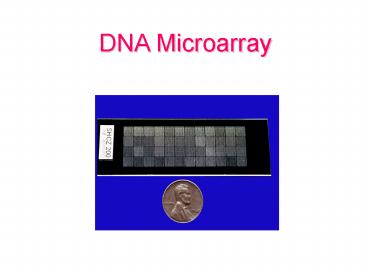DNA Microarray - PowerPoint PPT Presentation
1 / 40
Title: DNA Microarray
1
DNA Microarray
2
Microarray Printing
96-well-plate (PCR Products)
384-well print-plate
Microarray
3
(No Transcript)
4
Differential Expression
- Each cell contains a complete copy of the
organisms genome - Cells are of many different types and state
- e.g. blood, nerve, skin cells, etc
- What makes the cells different ?
- Differential gene expression, i.e., when, where
and in what quantity each gene is expressed - On average, 40 of our genes are expressed at
any given time
5
Functional genomics
- The various genome projects have yielded the
complete DNA sequences of many organisms. - e.g. human, mouse, yeast, fruitfly, etc.
- Human 3 billion base-pairs, 30-40 thousand
genes. - Challenge go from sequence to function,
- i.e., define the role of each gene and
understand how the genome functions as a whole.
6
Central Dogma
- The expression of the genetic information stored
in the DNA Molecule occurs in two stages - --transcription, during which DNA is
transcribed into mRNA - --translation, during which mRNA is
translated to produce a protein. - DNA mRNA Protein
cDNA Arrays
Tissue Arrays
7
(No Transcript)
8
(No Transcript)
9
(No Transcript)
10
The Central Dogma of Molecular Biology
11
Microarray Hybridization
12
Microarray Gene Expression Image
13
A Better Look
14
Image Analysis Data Visualization
Cy5 Cy3
log2
Cy3
Cy5
Experiments
8 4 2 fold 2 4 8
Underexpressed Overexpressed
Genes
15
SpotList
16
Ovarian Tumor Study M. Schaner
Samples that should Cluster together do not
17
(No Transcript)
18
Data Normalization
19
Pool of Cell Lines
Tumor
20
(No Transcript)
21
(No Transcript)
22
(No Transcript)
23
(No Transcript)
24
Such biases have consequences
- Plotting the frequency of un-normalized
intensities reveals the differential effect
between the two c hannels.
25
How do we deal with this?
- Normalization
- In general, an assumption is made that the
average gene does not change. - You must understand your experiment and data to
judge whether that assumption is a good one. - Usually true for gene expression experiments, but
not necessarily for aCGH or chromatin IP. - Generally true for large arrays, but not for
small " boutique" arrays.
26
Normalization The R-I Plot
- Data may have an intensity-dependent structure.
- Plot log2(R/G) vs. log10(RG) to reveal this
- Reveals
- variance in log ratios is greater at lower
intensities. - distribution may not be centered around zero.
27
Normalization Loess
log2(R/G)
log10(RG)
28
Cluster Analysis
- Cell Cycle example( Spellman 1988)
29
Overview of the Cell Cycle
- Purpose
- To create two new cells by dividing one original
cell
30
Cell Cycle Key Concepts
- All parts of original cell must be replicated and
split between new cells - Each step must occur in precise manner and timing
for successful cycle, and is strictly regulated - mRNA and proteins for cell cycle genes are found
at varying levels at different points of the
cycle - Mutations causing malfunction in regulation can
result in cancer
31
Yeast Cell Cycle
32
Cell Cycle Basic Description
http//www.bmb.psu.edu/courses/biotc489/notes/cycl
e.jpg
33
(No Transcript)
34
(No Transcript)
35
Cells grow out of synchrony.
36
(No Transcript)
37
(No Transcript)
38
(No Transcript)
39
(No Transcript)
40
(No Transcript)































